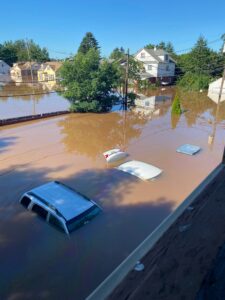Larry in the wings

September 1, 2021 – Broken power poles and downed electricity lines along a street in LaPlace, Louisiana. Courtesy, Kristina Overton, FEMA IMAT2
This morning’s death toll in the U.S. from Hurricane Ida stands at 67 in a surprising twist where the worst calamity was not at the point of landfall but days later and hundreds of miles away. And now, all eyes are on Hurricane Larry, which as of last night was a Category 3 storm and is likely to remain a “major hurricane” for several days, according to the National Hurricane Center. And while not projected to hit the U.S., it is expected to cause dangerous surf and rip currents along the Atlantic Seaboard. We who are storm weary yet storm ready know anything can change. We will keep you posted.
Recap & Current Situation: Hurricane Ida made landfall midday last Sunday, August 29, at Port Fourchon, Louisiana as a top end Category 4 storm with sustained winds of 150 mph and storm surge of almost 8 feet. Ida tied for strongest hurricane on record in Louisiana and 5th Strongest in the U.S. The new levees in New Orleans held and while thankfully it was no Hurricane Katrina (which struck LA 16 years ago to the day, flooding most of New Orleans) it made up for it with its surprising endurance and greater destruction over the following 5 days as it traveled through the Southeast and into the population-heavy Northeastern U.S. More people died there (27 in NJ, 17 in NY, 5 in PA, 1 in MD, and 1 in CT) than in the South (12 in LA, 2 in MS, and 2 in AL), mostly due to Ida’s record rain totals and historic floodwaters as it hit the Philadelphia/New York City area. Another four people are missing in NJ. Rivers are just now cresting with seven rivers reaching record high levels.

September 2, 2021 – Members of the NY State Police Underwater Recovery Team work along the Sprain Brook Parkway in Yonkers, checking stranded vehicles. Courtesy, NY State Police
Back in the South, it was bad enough. Officials say it could take until the end of this month for power to be restored to all of Louisiana! As of this past Sunday, only about 467,000 residents have had power restored from the total of 902,000 who lost power. More than 22,000 power poles, 26,000 spans of transmission wire, and 5,200 transformers were damaged. Mississippi and Alabama suffered impacts to a much smaller degree.
In Florida, Ida brought heavy rain to Pensacola with moderate street flooding in isolated areas and bands of showers elsewhere in the Panhandle. Ida was remarkable in part, for its especially long tail of rain. The storm was in Virginia Wednesday and it was still pouring in Tallahassee at times.
Damage Estimates: AIR Worldwide estimates that insured losses from Ida’s winds and storm surge will range from $17 billion to $25 billion, excluding rainfall-induced flooding, federal flood insurance losses, uninsured properties, and infrastructure losses. AIR’s loss estimates include adjustments for increased material and other repair costs in the current construction market. You can read more here. The Northeast U.S. impacts are expected to add tens of billions of dollars to that figure. So the original pre-landfall $40 billion estimate may ironically turn out to be not far off after all.
As of this past Friday, FEMA had received 290,000 requests for assistance. They have provided about $165 million in grants to Louisiana survivors and are helping 150,000 residents across multiple states. FEMA is tracking 13,500 National Flood Insurance Program claims in 18 states & D.C. You can get the latest updates going forward from Hurricane Ida | FEMA.gov.

September 2, 2021 – The view of flooded streets from a second floor home in Bound Brook, NJ near the Raritan River. Courtesy, Mike Domitrz via Facebook
President Biden on Insurance Losses: Last Thursday, President Biden targeted the property insurance industry, warning it not to “hide behind the fine print” of policies. Biden said that “right now” insurers are denying living expenses for victims “for additional living assistance expenses unless the homeowner was under a mandatory evacuation order.” The Louisiana Department of Insurance later urged insurance companies to voluntarily make additional ALE payments for policyholders who evacuated voluntarily in this Bulletin 2021-07. Some companies are doing so on their own. It’s easy for politicians to criticize insurance companies in the media. It takes leadership to work with organizations who are responding as fast as they can to help hurricane victims. As we know, policies vary and consumers should check with their insurance company.
LMA Newsletter of 9-7-21

